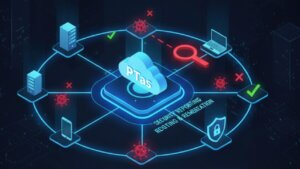In the world of cybersecurity, deception technologies have become a critical tool for detecting and mitigating threats. Among these technologies, honeypots and honeytokens are two of the most widely used. While both are designed to deceive attackers and gather intelligence, they serve different purposes and are suited to different use cases.
In this blog, we’ll explore the key differences between honeypots and honeytokens, their respective strengths and weaknesses, and the scenarios in which each is most effective. By the end, you’ll have a clear understanding of how to leverage these tools to enhance your organization’s security posture.
Table of Contents
What Are Honeypots?

A honeypot is a decoy system or network designed to attract and deceive cyber attackers. It mimics a real system, such as a server, database, or application, to lure attackers into interacting with it. Once an attacker engages with the honeypot, their actions are monitored and analyzed to gather intelligence about their behavior, tools, and techniques.
Key Characteristics of Honeypots:
Purpose: Detect and study attackers by simulating real systems.
Scope: Typically deployed as standalone systems or networks.
Interaction: High-interaction honeypots allow extensive interaction, while low-interaction honeypots simulate limited services.
Use Cases: Threat research, incident response, and deception strategies.
What Are Honeytokens?
A honeytoken is a piece of fake data or a digital artifact designed to detect unauthorized access or misuse. Unlike honeypots, which are entire systems, honeytokens are small, discrete elements that can be embedded within real systems or data. When an attacker interacts with a honeytoken, it triggers an alert, indicating a potential breach.
Key Characteristics of Honeytokens:
Purpose: Detect unauthorized access or insider threats.
Scope: Can be embedded in files, databases, APIs, or credentials.
Interaction: Minimal interaction; primarily used to trigger alerts.
Use Cases: Data breach detection, insider threat monitoring, and access control.
Honeypots vs. Honeytokens: Key Differences
To better understand the differences between honeypots and honeytokens, let’s break down their key characteristics:
| Aspect | Honeypot | Honeytoken |
|---|---|---|
| Purpose | Detect and study attackers by simulating systems. | Detect unauthorized access or misuse of data. |
| Scope | Simulates entire systems or networks. | Small, discrete elements embedded in real data. |
| Interaction | High or low interaction with attackers. | Minimal interaction; primarily triggers alerts. |
| Deployment | Requires dedicated resources and isolation. | Easily deployed within existing systems or data. |
| Complexity | More complex to set up and maintain. | Simple to create and deploy. |
| Use Cases | Threat research, incident response, deception. | Data breach detection, insider threat monitoring. |
Use Cases for Honeypots
Honeypots are particularly effective in the following scenarios:
1. Threat Research
Honeypots provide valuable insights into attacker behavior, tools, and techniques. Security researchers use honeypots to study emerging threats, such as new malware variants or zero-day exploits.
Example: A cybersecurity firm deploys a high-interaction honeypot to study the tactics of an Advanced Persistent Threat (APT) group.
2. Incident Response
Honeypots can serve as early warning systems, alerting organizations to potential breaches. By monitoring interactions with the honeypot, security teams can detect and respond to attacks before they reach critical systems.
Example: A company places a honeypot in its DMZ to detect and analyze attempted intrusions.
3. Deception Strategies
Honeypots are a key component of deception technologies, which aim to mislead and confuse attackers. By creating a network of decoys, organizations can waste attackers’ time and resources.
Example: A financial institution deploys multiple honeypots across its network to divert attackers from real assets.
Use Cases for Honeytokens
Honeytokens are particularly effective in the following scenarios:
1. Data Breach Detection
Honeytokens can be embedded in files, databases, or APIs to detect unauthorized access. When an attacker interacts with the honeytoken, it triggers an alert, indicating a potential breach.
Example: A healthcare organization embeds honeytokens in patient records to detect unauthorized access.
2. Insider Threat Monitoring
Honeytokens can be used to monitor for insider threats, such as employees leaking sensitive information. By placing honeytokens in sensitive documents, organizations can detect and respond to insider threats quickly.
Example: A technology company places honeytokens in confidential product designs to monitor for leaks.
3. Access Control
Honeytokens can be used to test and validate access controls. For example, a honeytoken embedded in a restricted file can help identify weaknesses in access control policies.
Example: A government agency uses honeytokens to test the effectiveness of its access control mechanisms.
Strengths and Weaknesses
Honeypots
Strengths:
Provide detailed insights into attacker behavior.
Can simulate complex systems and networks.
Effective for studying advanced threats.
Weaknesses:
Require significant resources to set up and maintain.
Can be detected by sophisticated attackers.
Pose a risk if not properly isolated.
Honeytokens
Strengths:
Easy to create and deploy.
Can be embedded in existing systems or data.
Effective for detecting unauthorized access and insider threats.
Weaknesses:
Provide limited information about attacker behavior.
Require careful placement to be effective.
May generate false positives if not properly configured.
Combining Honeypots and Honeytokens
While honeypots and honeytokens serve different purposes, they can be used together to create a comprehensive deception strategy. For example:
Layered Defense: Use honeypots to detect external threats and honeytokens to monitor for insider threats.
Enhanced Detection: Combine honeypots with honeytokens to detect both system-level and data-level breaches.
Comprehensive Intelligence: Use honeypots to gather detailed threat intelligence and honeytokens to validate access controls.
Example: A retail company deploys honeypots to detect external attacks on its e-commerce platform and embeds honeytokens in customer databases to monitor for unauthorized access.
Real-World Examples
Honeypot in Action
A cybersecurity research team deploys a honeypot that mimics a vulnerable IoT device. The honeypot attracts attackers attempting to exploit the device, allowing the team to study their methods and develop countermeasures.
Honeytoken in Action
A financial institution embeds honeytokens in sensitive financial documents. When an employee attempts to leak the documents, the honeytoken triggers an alert, enabling the organization to respond quickly.
Conclusion
Honeypots and honeytokens are both powerful tools in the cybersecurity arsenal, but they serve different purposes and are suited to different use cases. Honeypots are ideal for detecting and studying attackers by simulating real systems, while honeytokens are effective for detecting unauthorized access and insider threats.
By understanding the differences between these two tools and leveraging their strengths, organizations can create a comprehensive deception strategy that enhances their ability to detect, analyze, and respond to cyber threats. Whether you’re defending against external attackers or monitoring for insider threats, honeypots and honeytokens offer unique and valuable capabilities that can help you stay one step ahead of cybercriminals.
Why Businesses Trust SecureMyOrg for Comprehensive Network Security
At SecureMyOrg, we uncover and fix all possible security vulnerabilities of mobile and web, while providing solutions to mitigate risks. We are trusted by renowned companies like Yahoo, Gojek and Rippling, and with 100% client satisfaction, you’re in safe hands!







Some of the things people reach out to us for –
- Building their cybersecurity program from scratch – setting up cloud security using cost-effective tools, SIEM for alert monitoring, building policies for the company
- Vulnerability Assessment and Penetration Testing ( VAPT ) – We have certified professionals, with certifications like OSCP, CREST – CPSA & CRT, CKA and CKS
- DevSecOps consulting
- Red Teaming activity
- Regular security audits, before product release
- Full time security engineers.
Relevant Posts

AI-Powered Phishing Emails: 7 Ways to Spot and Stop Them Before They Strike
Penetration testing as a service (PTaaS) lets experts simulate real attacks to uncover vulnerabilities before hackers do. This guide explains the process, benefits, and costs, helping businesses strengthen defenses with predictable, ongoing security checks.

Why Regular Penetration Testing is Essential for Modern Companies
Penetration testing as a service (PTaaS) lets experts simulate real attacks to uncover vulnerabilities before hackers do. This guide explains the process, benefits, and costs, helping businesses strengthen defenses with predictable, ongoing security checks.

What Is Penetration Testing as a Service?
Penetration testing as a service (PTaaS) lets experts simulate real attacks to uncover vulnerabilities before hackers do. This guide explains the process, benefits, and costs, helping businesses strengthen defenses with predictable, ongoing security checks.

How To Inspect Encrypted Traffic Without Breaking Privacy
Network administrators face a challenge: securing systems while respecting privacy. This guide explains how to inspect encrypted traffic without breaking privacy using metadata, anomaly detection, and machine learning ensuring visibility, compliance, and trust.

How to Audit Infrastructure as Code (IaC) for Security Vulnerabilities
Discover how to audit Infrastructure as Code (IaC) for security vulnerabilities with this practical guide. Learn to scan IaC files using tools like Checkov, fix issues like exposed resources, and integrate audits into CI/CD pipelines. Protect your cloud systems from misconfigurations and ensure compliance with clear, actionable steps.

DevSecOps Best Practices: Integrating Security Early in Your CI/CD Pipeline
This article provides a practical guide to embedding security into every stage of your CI/CD pipeline. Learn core DevSecOps best practices like SAST, DAST, dependency scanning, secrets management, and compliance automation to catch vulnerabilities early, foster a culture of shared ownership, and build a secure-by-design development process that accelerates release cycles.

